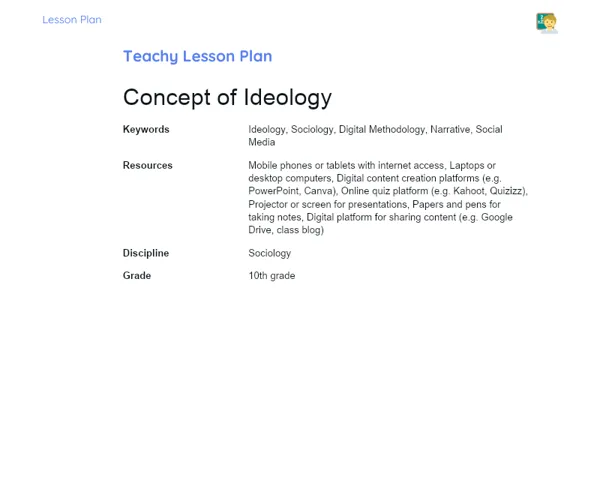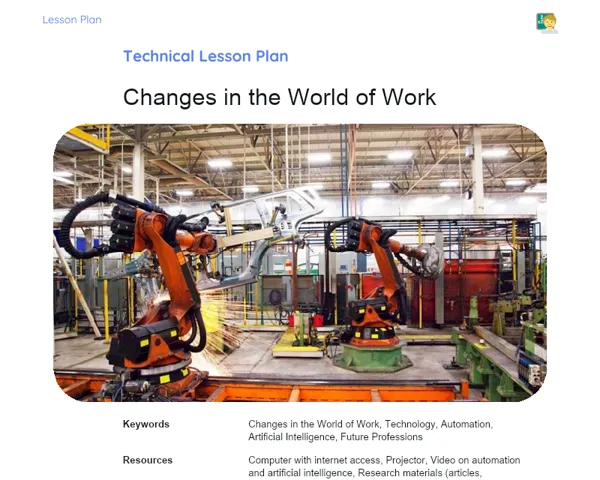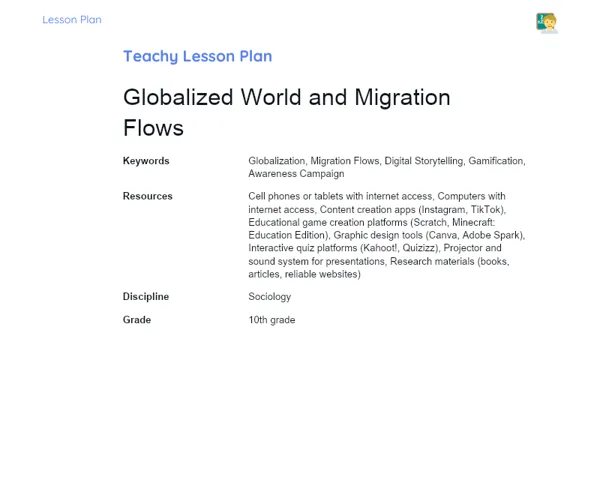Lesson Plan | Lesson Plan Tradisional | Changes in the World of Work
| Keywords | Forms of Work, Industrial Revolution, Modern Work, Flexibility, Remote Work, Gig Economy, Technologies, Automation, Artificial Intelligence, Big Data, Internet of Things (IoT), Continuous Education, Future of Work |
| Resources | Whiteboard or digital board, Markers or pens for the board, Projector or screen for presentations, Computer or laptop for the teacher, Presentation slides on the evolution of work and technologies, Notepaper and pens for student notes, Internet access for displaying videos or additional articles, Printed or digital material with data and graphs on changes in the job market |
Objectives
Duration: (10 - 15 minutes)
This stage aims to provide a straightforward overview of what will be covered in class. It sets the scene for students, helping them grasp the context and objectives of our discussion, making it easier for them to absorb content and follow subsequent explanations. By laying out the main objectives, students can concentrate on the key points and appreciate the social and economic implications of changes in the modern workplace.
Objectives Utama:
1. Identify and distinguish various forms of work throughout history.
2. Examine shifts in modern work dynamics, especially with the rise of technology.
3. Understand the impact of tech tools on workplace relationships and the job market.
Introduction
Duration: (10 - 15 minutes)
The aim of this stage is to provide a robust historical and current context, enabling students to grasp the trajectory and evolution of various forms of work. This foundational knowledge is critical for understanding future discussions on transformations in modern work and the effect of technology.
Did you know?
Did you know that a study suggests by 2030, around 375 million workers globally may need to switch careers due to automation and artificial intelligence? This data highlights how swiftly technology is reshaping the job market, directly impacting the lives of many, possibly even yours down the line.
Contextualization
To kick off the lesson on 'Changes in the World of Work', it's crucial to give students a historical background on the evolution of work. Start by discussing how, in ancient times, economies were primarily based on farming and craftsmanship. Then transition to the Industrial Revolution, emphasising the switch to mass production and mechanisation of labour. Next, cover the rise of the service sector and, ultimately, the Information Age with its digital technologies. This historical framework will help students understand how work has transformed over time and the significance of recent technological shifts.
Concepts
Duration: (40 - 50 minutes)
This stage aims to deepen students' understanding of how the world of work is changing, offering a thorough and critical analysis of historical and modern transformations. By examining these topics, students will grasp the complex dynamics of today's job market, the effects of technology, and potential future trends. The proposed questions will boost critical thinking and encourage practical application of the concepts we've discussed.
Relevant Topics
1. Forms of Work Throughout History: Discuss the main forms of work from ancient times to now. Focus on the agrarian and artisanal economies of the past, the transition to mass production and mechanisation during the Industrial Revolution, the rise of the service sector, and finally the Information Age with the impact of digital technologies.
2. Changes in Modern Work: Explore how modern work has developed, highlighting key changes from the past few decades, such as work flexibility, the growth of remote jobs, the gig economy, and the increasing value of interpersonal and cognitive skills.
3. Impact of Technologies: Discuss how tech tools are reshaping the job market. Stress topics like automation, artificial intelligence, big data, the Internet of Things (IoT), and digital platforms. Explain how these technologies are generating new opportunities as well as challenges, like the need for reskilling.
4. Future of Work: Talk about predictions and trends for the future of work. Cover topics such as automation of repetitive tasks, the rising importance of digital skills, the transformation of workplaces, and the socio-economic impacts of these changes. Highlight the importance of continuous learning and adaptability for future employees.
To Reinforce Learning
1. How did the Industrial Revolution change work practices, and what were its key social and economic consequences?
2. What are the main challenges and opportunities that automation and artificial intelligence pose to today's job market?
3. How are the gig economy and remote work altering traditional employment relationships? Provide some real-life examples.
Feedback
Duration: (20 - 25 minutes)
This phase aims to solidify the knowledge gained during the lesson by actively engaging students in discussion and reflection on the topics addressed. This encourages deeper understanding, fosters critical thinking, and allows students to connect the theories discussed to their own experiences and future aspirations.
Diskusi Concepts
1. How did the Industrial Revolution change work practices, and what were its key social and economic consequences? Detail: The Industrial Revolution signified a shift from manual and artisan work to mechanised mass production, which boosted productivity and led to the establishment of factories, but also resulted in severe working conditions, long hours, and low pay. Socially, it triggered urban migration, changed family dynamics, and spurred the formation of labour movements advocating for better conditions. 2. What are the main challenges and opportunities that automation and artificial intelligence pose to today's job market? Detail: Automation and AI offer opportunities like improved efficiency and new job creation. However, they present challenges, such as potential job losses, the need for reskilling, and increasing disparities between those with advanced tech skills and those without. 3. How are the gig economy and remote work altering traditional employment relationships? Provide some real-life examples. Detail: The gig economy encompasses temporary, freelance jobs that offer flexibility and independence, yet may lack traditional benefits and job stability. Remote work, significantly accelerated by the COVID-19 pandemic, facilitates a better work-life balance but can also lead to isolation and blurring lines between work and personal time. Examples include platforms like Uber and Upwork in the gig economy, and companies such as Google and Microsoft adopting remote work policies.
Engaging Students
1. How do you think the emergence of new technologies could influence your future career? 2. Which skills do you think will hold the most value in the future workplace? Explain your reasoning. 3. Do you prefer the idea of working remotely or in an office setting? What are the pros and cons of each? 4. How do you perceive the importance of continuous learning in preparing for a shifting job market? 5. In what ways could the gig economy impact your job prospects moving forward? Do you see it as a viable option?
Conclusion
Duration: (10 - 15 minutes)
This stage aims to reinforce the knowledge gained during the lesson, highlighting the main points discussed and underlining their practical relevance. It ensures students leave with a clear understanding of the topics tackled, better preparing them for future discussions and their entry into the job market.
Summary
['The history of various work forms from ancient times to the present.', 'The impact of the Industrial Revolution on work transformation.', 'Changes in modern work, such as flexibility, remote jobs, and the gig economy.', 'The effects of technological advancements like automation and artificial intelligence on the job market.', 'Forecasts and trends for the future of work, emphasising the significance of digital skills and lifelong learning.']
Connection
The lesson situated the discussion of changes in the world of work within a historical context, demonstrating how technological and social transformations have influenced job forms. By discussing practical examples like the gig economy and remote work, the lesson linked theory with practice, allowing students to see how these changes impact the current job market and their career paths.
Theme Relevance
Understanding the shifts in the world of work is critical for students as they prepare for an ever-evolving job market. Recognising the impact of technology and new work dynamics equips them with the skills needed to adapt to new realities. For instance, automation could reshape their future roles, necessitating continual reskilling and adaptability.



